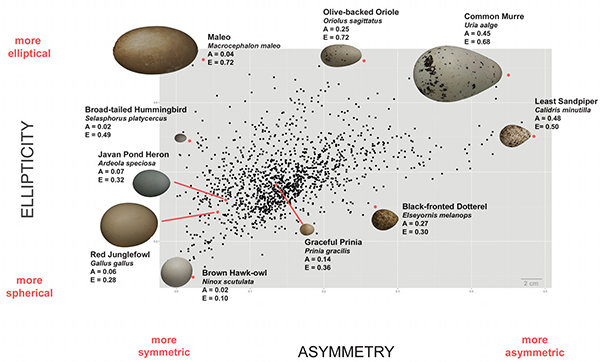The evolution of the amniotic egg - complete with membrane and shell - was key to vertebrates leaving the oceans and colonizing the land and air. Now, 360 million years later, bird eggs come in all shapes and sizes, from the almost perfectly spherical eggs of brown hawk- owls to the tear-drop shape of sandpipers' eggs. The question is, how and why did this diversity in shape evolve?
The answer to that question may help explain how birds evolved and solve an old mystery in natural history.
An international team of scientists led by researchers at Harvard and Princeton universities, with colleagues in the UK, Israel and Singapore, took a quantitative approach to this question. Using methods and ideas from mathematics, physics and biology, they characterized the shape of eggs from about 1,400 species of birds and developed a model that explains how an egg's membrane determines its shape. Using an evolutionary framework, the researchers found that the shape of an egg correlates with flight ability, suggesting that adaptations for flight may have been critical drivers of egg-shape variation in birds.
The research is published in Science.
The researchers began by plotting the shape - as defined by the pole-to-pole asymmetry and the ellipticity - of some 50,000 eggs, representing 14 percent of species in 35 orders, including two extinct orders.
The researchers found that egg shape was a continuum - with many species overlapping. The shapes ranged from almost perfectly spherical eggs to conical-shaped eggs.
So, how is this diverse spectrum of shapes formed?
Researchers have long known that egg membranes play an important role in egg shape - after all, if an egg shell is dissolved in a mild acid, like vinegar, the egg actually maintains its shape. But how do the properties of the membrane contribute to shape?
Think of a balloon, said Mahadevan. If a balloon is uniformly thick and made of one material, it will be spherical when inflated. But if it is not uniform, all manner of shapes can be obtained.
So, how is this diverse spectrum of shapes formed?
Researchers have long known that egg membranes play an important role in egg shape - after all, if an egg shell is dissolved in a mild acid, like vinegar, the egg actually maintains its shape. But how do the properties of the membrane contribute to shape?
Think of a balloon, said Mahadevan. If a balloon is uniformly thick and made of one material, it will be spherical when inflated. But if it is not uniform, all manner of shapes can be obtained.
